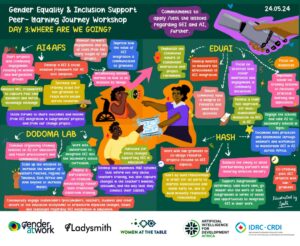A few reflections: Do tools have a place in feminist work?
For Gender at Work, the approach we take to gender equality and inclusion work typically focuses on longer-term action learning processes. We value reflective space and aim to create an opportunity for people to work together and to learn from each other over time, and typically tailor our support to meet specific needs.
Recently we’ve been having some internal debate and discussion about the role of tools and resources in the work that we do. When we think of tools, the image that comes to mind is often one of checklists or simple resources, which can risk focusing on a quick fix to a problem. This raises questions like:
- When it comes to ‘best practices’, whose practices do we tend to default to?
- Do we risk perpetuating norms about whose information matters more when we develop how-to guides and checklists?
- Can tools and resources then ever truly be part of a longer term, feminist approach?
Real change does, of course, take time. Yet if we think of these tools more as guiding documents or ‘learning resources’ I’d suggest that there may be a place for them within a feminist space, depending on the resource itself and the spirit in which it is created. While a checklist, for example, may not allow for contextual, geographic, and project-related nuances in gender equality work, there are other interesting approaches that can be taken to the development of resources and tools that aim to meet a specific need as identified by partners.
There are a few key arguments to be made for including these resources, where appropriate, in our broader approach, which include:
- We can share some general learning. There is some learning that we acquire over time through our work that can be generalized, captured, and used to kick-start important conversations.
- We can connect with a larger audience: Resources allow us to connect with a broader audience than we otherwise might in our smaller peer learning-focused projects.
- We can make knowledge from technical experts more readily available: In some of our recent projects we’ve brought in gender specialists who have expertise in data, artificial intelligence, or the education sector to share their knowledge and insight in a way that might not be possible in 1:1 mentoring relationships.
This is, of course, not to imply that tools and resources can ever replace the importance of developing and nurturing genuine partnerships over time. We know that partners need the space and support to solve problems in ways that make sense to them and their context, and that this requires ongoing engagement. Instead, perhaps we can think of resources such as this Gender Conversation Guide as complementary to the support that we provide, and as part of an overall menu of offerings that can be contextualized and designed to meet partner and project needs.
Read The Gender Equality & Inclusion Conversation Guide to learn more about how we’ve approached this in some of our recent work.
This blog post was written by Shannon Sutton, Gender at Work Associate, in the context of her work in partnership with IDRC. Learn more about it here: Partnering Up to Advance Gender Equality in Development Research.



